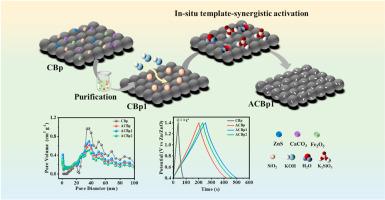Hierarchical porous carbon from waste tire pyrolysis carbon black via in-situ SiO2 templating for high-performance supercapacitors
IF 7.9
2区 工程技术
Q1 CHEMISTRY, PHYSICAL
引用次数: 0
Abstract
Realizing high-value recycling of pyrolysis carbon black (CBp) is essential to promoting the sustainable development of the waste tire pyrolysis industry. However, the high-end applications of CBp are restricted by its high ash content, small specific surface area and poor electrical conductivity. Herein, waste tire-derived CBp were successfully converted to hierarchical porous activated carbon (ACBp1) for high-performance supercapacitors by one-step acid purification coupled with in-situ SiO2 template activation. This method not only greatly reduces the ash content by avoiding use of environmentally-hazardous hydrofluoric acid, but also is beneficial to forming a rich interconnected pore structure to increase the ion and electron migration rate. ACBp1 achieves a specific capacitance of 246 F g−1 at current density of 1 A g−1, while maintaining 95 % of initial capacitance after 100,000 charge-discharge cycles at 100 A g−1. The ACBp1-based zinc ion hybrid supercapacitor demonstrates a high specific capacity of 66 mAh g−1 at 0.5 A g−1. This study provides a new idea to improve the utilization efficiency of CBp and offers a new way to further develop cheap and sustainable energy storage materials.

从废轮胎热解炭黑中提取分级多孔炭,通过原位SiO2模板制备高性能超级电容器
实现热解炭黑(CBp)的高价值循环利用是促进废轮胎热解产业可持续发展的关键。然而,CBp的高端应用受到其灰分高、比表面积小和导电性差的限制。本研究通过一步酸净化和原位SiO2模板活化,成功地将废轮胎源CBp转化为用于高性能超级电容器的层次化多孔活性炭(ACBp1)。该方法不仅避免了使用对环境有害的氢氟酸,大大降低了灰分含量,而且有利于形成丰富的互联孔隙结构,提高离子和电子的迁移速率。ACBp1在电流密度为1 a g−1时的比电容为246 F g−1,在100 a g−1下充放电10万次后仍保持95%的初始电容。acbp1基锌离子杂化超级电容器在0.5 a g−1时具有66 mAh g−1的高比容量。本研究为提高CBp的利用效率提供了新的思路,为进一步开发廉价、可持续的储能材料提供了新的途径。
本文章由计算机程序翻译,如有差异,请以英文原文为准。
求助全文
约1分钟内获得全文
求助全文
来源期刊

Journal of Power Sources
工程技术-电化学
CiteScore
16.40
自引率
6.50%
发文量
1249
审稿时长
36 days
期刊介绍:
The Journal of Power Sources is a publication catering to researchers and technologists interested in various aspects of the science, technology, and applications of electrochemical power sources. It covers original research and reviews on primary and secondary batteries, fuel cells, supercapacitors, and photo-electrochemical cells.
Topics considered include the research, development and applications of nanomaterials and novel componentry for these devices. Examples of applications of these electrochemical power sources include:
• Portable electronics
• Electric and Hybrid Electric Vehicles
• Uninterruptible Power Supply (UPS) systems
• Storage of renewable energy
• Satellites and deep space probes
• Boats and ships, drones and aircrafts
• Wearable energy storage systems
 求助内容:
求助内容: 应助结果提醒方式:
应助结果提醒方式:


